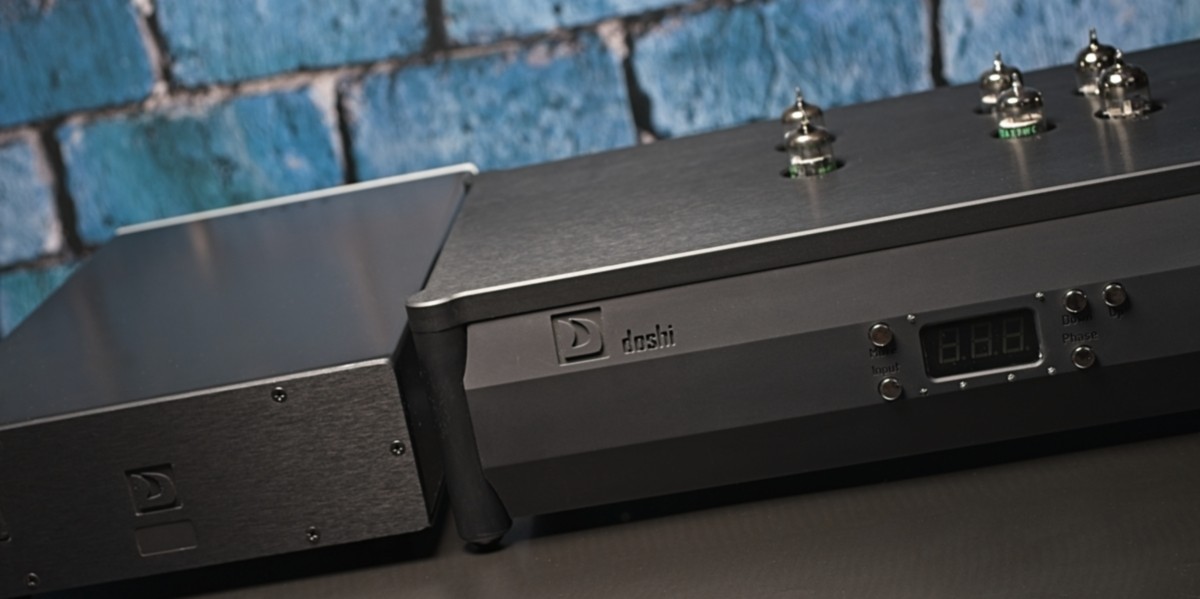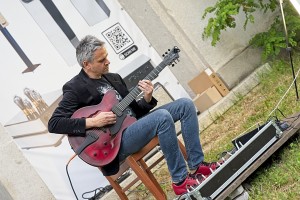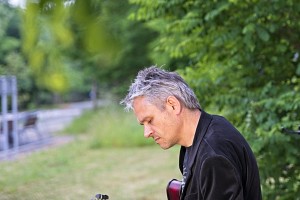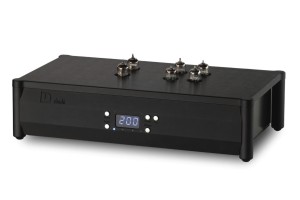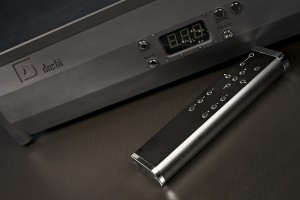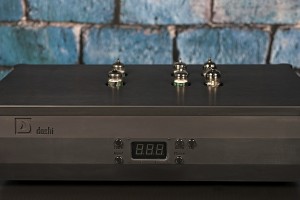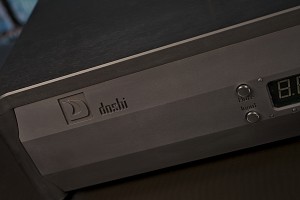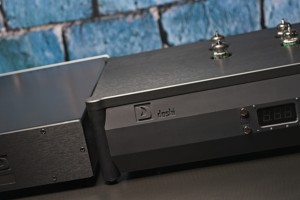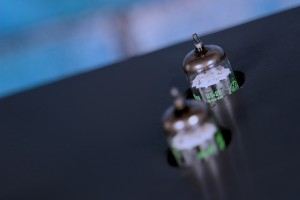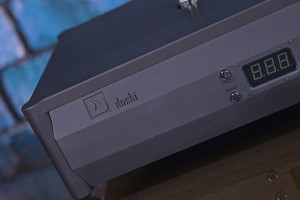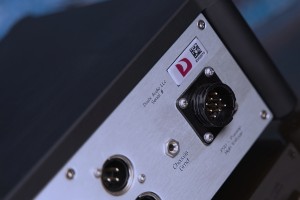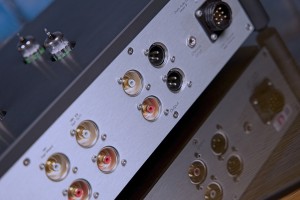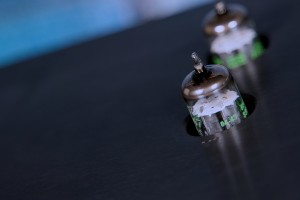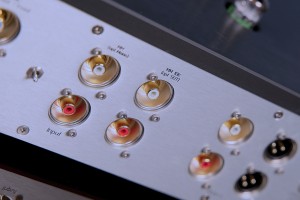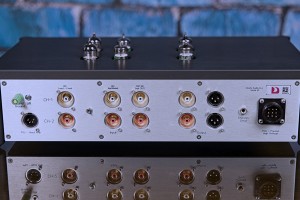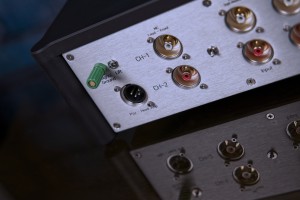It so happens that most of my personal top ten phonostages are tube (or at least hybrid) devices. Will the latest Nick Doshi’s design join the ranks of the best of the best? I definitely hope so. Let’s find out whether Doshi Audio Evolution Phono Preamplifier measures up to the likes of Kondo, Audio Tekne, Ypsilon, or Tenor Audio.
Introduction
Over a year ago I finally met Nick Doshi and had a chance to listen to his electronics for the first time. It was in Munich at the High-End Show in a room Doshi Audio shared with J.Sikora. Later, Janusz Sikora delighted with Nick’s phonostage ordered one for himself. That’s your and my first clue – if our turntable wizard was so impressed with this component it had to be really, really good. That was also my impression from the High End Show, although I listened there to a whole system, not just the phono, so all I could tell was that the setup delivered impressive performance. It seems that the brand isn’t particularly popular in Europe which in part is justified by the boutique size of its operation. Yet, the impressions from Munich strongly suggested that it was worth getting to know.
A few months later the ordered unit arrived in Lublin and soon after was presented at the Audio Video Show in Warsaw. It was yet another successful presentation, although again, of a whole setup. After that, I had a chance to listen to the Evolution Phono Preamplifier twice more in the J.Sikora’s showroom, and again in Munich this year. After all these experiences Sikoras completed the Doshi setup by ordering also a line preamplifier and monaural power amplifiers. I haven’t mentioned it so far, but all of them are tube devices. In Munich I also had a chance to interview Nick – you will find the transcript below, and we agreed that I would prepare a review of the phono stage. So here we are. Instead of a longer introduction to the new brand let me share what Nick told me about himself, his company, and his designs.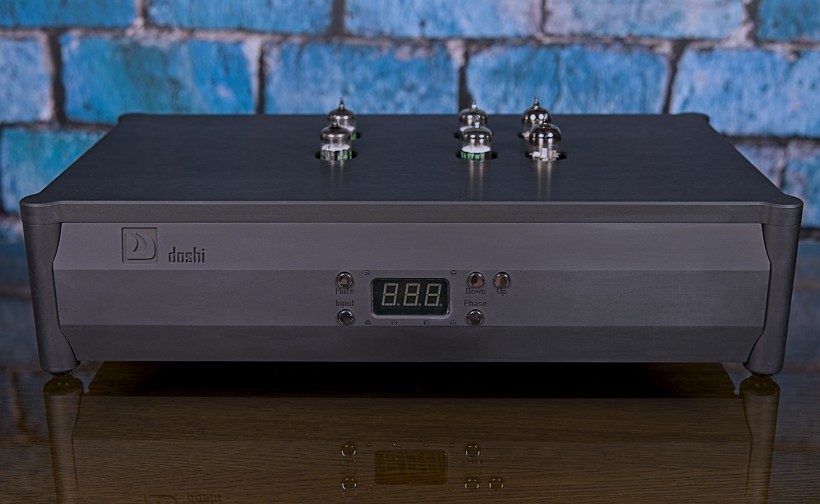
I met with Nick at the Munich High End Show prior to this review and I had a chance to talk to him. Below you will find a transcript of our conversation that will give you a little insight into Nick Doshi’s career and designer’s philosophy.
Marek Dyba (MD): Let’s start with Nick Doshi’s background, then the company, and then we can talk about the phono stage.
Nick Doshi (ND): So, my background… I had a higher education in my undergrad, it was in physics, and then I had an electrical engineering grad school, so that was the education part. When I was an undergrad in college, I went to my college radio station and asked them if I could fix tape machines. They said, yeah, here are the keys, you’re hired. That’s how it started.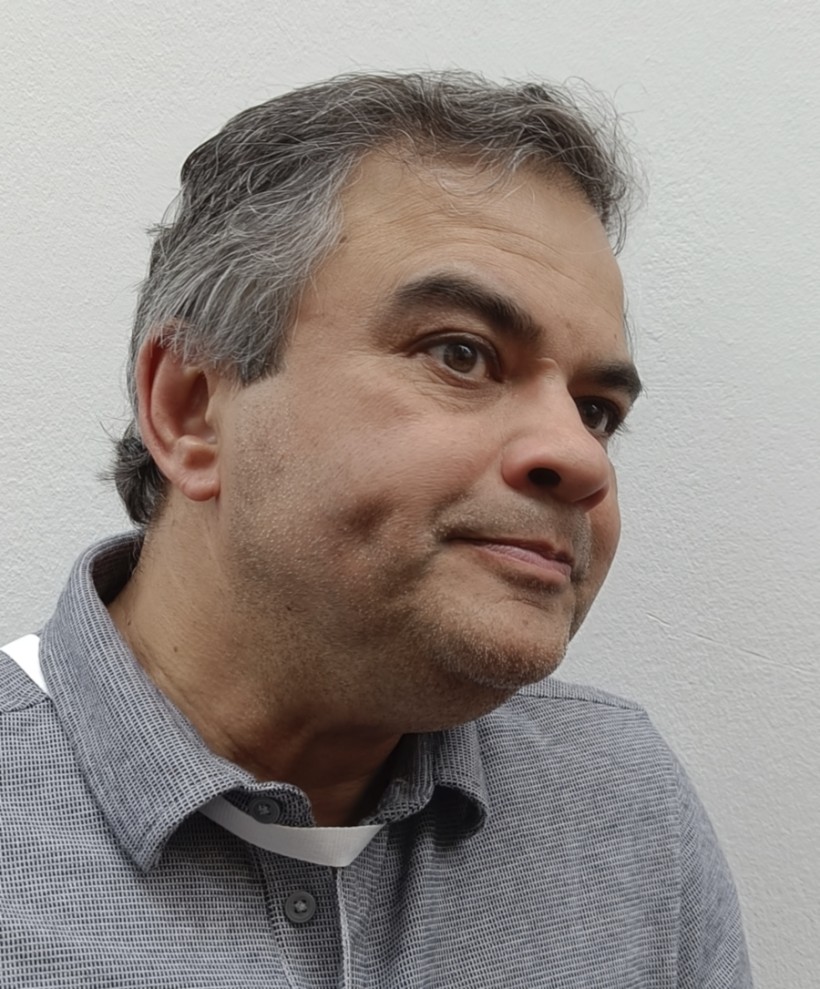
MD: But you just said you could repair such devices or you really could do it?
ND: I could. That led to a 25-year-plus career in radio and television broadcast, including working with PBS, the public broadcast system. That’s a short form of my background. But alongside that, because both my parents were very into Indian classical music and those things, and when I moved to the United States, I became very interested in jazz along with rock and roll. I was always kind of split between the electric and electronic sides and also loved music. I was always interested in audio equipment, and I was 11 years old when I built a pair of speakers. Later on, I moved to electronics, modifying things. In India, you have to rebuild everything because you don’t have the parts. It was a good education on how things are put together and constructed and everything else. When I moved, even though I was working, I did not have too much money, so I kept building my own equipment. And then one day in 2003, somebody came over to my house to buy a used preamplifier and happened to listen to one that I had built, turned out that they liked it and asked me to build one for them. One of my devices and they subsequently brought some people who wanted to listen to what I’d built. And they said they wanted the same thing for themselves. And then two or three of the same type of people expressed interest in my work.
MD: What was this first design? An amplifier?
ND: This first thing was a little preamplifier. It was one moving coil input, one line out, and one volume control. That was it.
MD: Was it a tube device?
ND: Yes, it was a tube device. It was the first generation of the preamplifier called the V series (v 1/2), so different topology, but the same design philosophy. That started the whole journey. And so, Doshi Audio was born, and now we’ve been operating for 22 years. For a number of years, I was working full-time, making pieces part-time. Now we’re more streamlined production and everything else. You know, that’s the evolution of it. For many, many years, I would say up to 2018 or 19, we were focused on industry partners. We had a lot of customers, but they all tended to be people from inside the industry. Professional folks or audio manufacturers wanted pieces for their personal systems, so it’s been the industry’s best-kept secret for a long time and that established a little bit of credibility within the industry and also established the reputation for reliability and good sound. The vital thing with that was that by supplying industry people, I was able to get very honest feedback. I’m a very stubborn person. I always think that what I’m thinking is the best.
MD: Many designers do.
ND: And designers, they’re like, well I finished the circuit and I don’t care how the rest of it looks like, so that kind of feedback regarding the packaging, the looks, and many other things it was a good educational experience in the industry side of things. And then with the V3, and then subsequently with the Evolution series, we kind of started to move more towards the established dealer relationships and various types of things.
MD: You said you cared mostly about the circuit, not the rest, so after you got some feedback, did you still design the exterior yourself or did you find someone else to do it for you?
ND: I designed it myself. My philosophy for the inside as well as the outside is that form has to follow the function. So if you look at, say for instance, a phono preamplifier, why did I design it as a differential with JFETs? And why of all things is there a transformer on the output, because a moving coil cartridge is a balanced device, it’s a, you know, it’s a coil, but it has a signal on both leads, right? So you have to treat it like a balanced device, you need a balanced amplifier, a differential amplifier, so that you get the maximum amount of noise cancellation, plus you get 6 dB more signal-to-noise ratio. Why should you ground one side to lose that?
MD: But does it matter whether you connect it with RCA or XLR?
ND: No. A balanced signal is two, or a differential signal is just two wires, right? So in RCA, you have two wires. The ground doesn’t play a role. The only reason for a ground would be to prevent a ground loop or inducted hum, things like that. So that was the whole thinking behind that, but the other part of the design was I wanted to use zero feedback and have the minimum amount of gain stages.
MD: So in your opinion, it’s better to have fewer gain stages with higher gain than lots with smaller ones?
ND: If you can keep them linear, and tubes are a great way of getting gain, but very linear, right? So the moving magnet, the 55 dB section of the unit is tubes. So now I had a differential balanced moving coil but I had to convert it to single-ended for the tube stage. So I used an output transformer. And what that does is it gives you multiple advantages. So first, you can go from balanced to single-ended with no issues whatsoever. Second, you have complete isolation from the moving coil amplifier to the tube. So all of the power supply currents and everything. There are two in my phono stage. One is for the moving coil amplifier and one is for the tube section. They’re completely isolated. So they don’t interfere with each other. And number three is that the design of the head amplifier is 30 dB of gain. I don’t need 30 dB of gain. I need 24, 20, 20-something dB of gain to make 74 dB, 73 dB.
MD: Which is a lot, actually.
ND: It’s a lot. So what I did was I stepped it down to 1. So the voltage is actually a step down on the moving coil amplifier. So when you do a voltage step down of 2 to 1, you do an impedance step down of 4 to 1. So now the output impedance of your coil amplifier is virtually meaningless, which is very important when you’re driving tubes, because of the Miller capacitance of the gain of the tube. You’re driving a capacitive load, so you need a very low output impedance. Now you’ve got the best operating conditions. So that was the whole design and I had to make things fit so that they work with each other.
MD: As I understand there is also a special design of the chassis itself.
ND: Yes, so moving on to the form factor on the chassis. All the materials are stainless steel, all the chassis materials are stainless steel even the screws so everything in the chassis is non-metallic. The main audio board that holds the tubes is suspended from the top of the chassis with vibration isolation. So it is mechanically decoupled from everything that’s going on. Tubes are microphonic, but not through the glass. They are microphonic through the pins. So to isolate pins, you have to isolate tube sockets. So the whole thing sits on vibration isolation.
MD: What kind of tube sockets do you use?
ND: We use Teflon sockets with machined OFC copper gold-coated pins. The reason for that is not because we just like to spend ten times more money than everybody else, but that such a socket will never fail. It will always have good contact, and it will always be reliable, and that’s the pride of these broadcasting platforms, reliability is really important. So yes, that tube socket in bulk cost me $9, versus a regular tube socket costing $0.50, $0.60. But it will never fail, the end-user will never have to jiggle the tubes, and so on.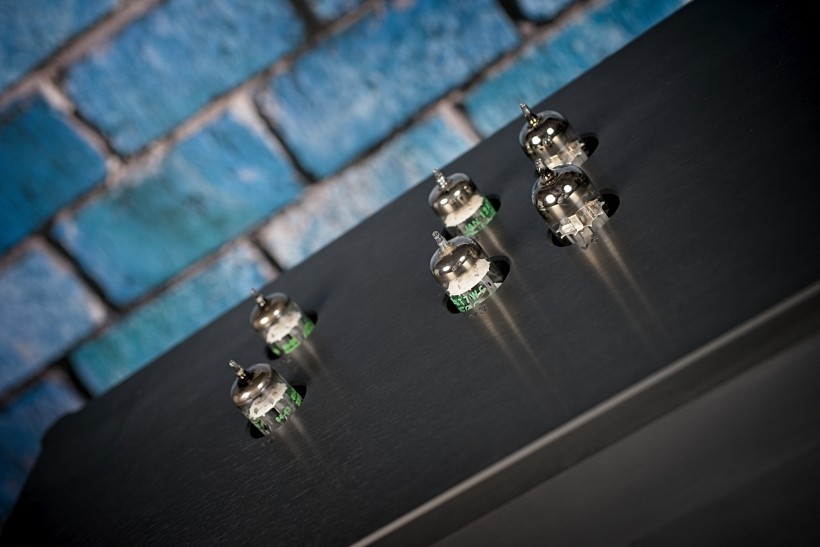
MD: But if the whole board is suspended, does it mean that the tubes are upside down?
ND: No, they are suspended from the top. So then the tubes are upside and then they come out of the top. They kind of look cool, but also you can change tubes if you want to try some tube rolling without opening everything. That was the idea. And then the top plate has four legs that raise the whole chassis so the bottom of the chassis is not touching it. All the vibrational energy goes to a half-inch thick aluminum-constrained layer down the top plate. It’s just dead. There’s nothing happening. You can hit the top of the funnel pan hard, but it won’t have any effect. So that was the idea. And it looks nice, too. It has a very nice form.
MD: Yes, it does!
ND: You know, I partnered up with the folks in Radison in Canada, and they made it look beautiful. I said, here’s what I want to do. This is the top plate, I want four legs and then send me a sketch back with the beveled front. So it came out nice. That was it.
MD: What tubes do you use?
ND: I use common tubes, I don’t use any esoteric tubes. The first amplification stage is 12AX7, the driver for the RIAA is 12AT7, and the output, it’s 12DW7.
MD: And all of them are from current production?
ND: All from current production. Whenever I can make bulk purchases of NOS tubes, I like to provide my customers with NOS tubes. I bought over 600 pcs of 12AT7s that were Joint Army Navy surplus. All my units are designed to work with current production tubes. No esoteric tubes in there. I’m a believer that, as far as tube design goes, the RCA engineers and the Sylvania engineers who designed the original audio tubes, were geniuses. These are the most linear amplification devices. They work without feedback. And so, just for the sake of being special, I’m not going to force my customers to buy some esoteric tube that you can only find on the far beaches of South America or something like that. I’m not going to do that. So, this is the reason that we just use regular tubes that everybody can use. You can buy them at a guitar shop, you can replace them at home. That was the whole idea behind it. And I think the focus of the circuit was dynamic linearity. It had to be able to do the dynamics, the whole dynamic envelope of whatever performance is being played without any compromise. That was the idea, to present to the listener, to the music lover, that emotional content, the way the music reads, the way the performers perform. They’re all listening to each other and talking to each other, and you want to be able to be a part of that. That’s the reason we do this.
MD: It’s not that everybody really wants this, but okay. You see, for me it’s always about music, right? I love live music and what I want at home is to have at least a similar feeling.
ND: I want my devices to touch the emotional part of you. So that was the, you know, whether I’m good or whether I’m lucky, I don’t know. But I succeeded, you know, where I wanted to, what I wanted to have. At least so far.
MD: Do the people who buy the photo stage from you buy also the amplifiers and all the rest, or just the photo stage?
ND: Well, it’s interesting, that the products that would kind of lead the market, would be the tape preamplifier, or the phono preamplifier, or the headphone amplifier, that kind of thing. So, a single product. And then they get it and they go, oh, I wonder how good the other devices are. So we are able to cultivate those customers. They start with the phono stage, then they go with the line stage and the reaction is often” “Oh my God!”. And then, they come to a show and they listen to the amps. There have been many customers who started with one product and ended up with more. That’s a good sign.
MD: Do you have your favorite or preferred cartridges or brands whose products work particularly well with your phono stage?
ND: I don’t know. No, I mean, so this is the joy of partnering with different people at shows and so on. You get to hear a lot of phono stages, cartridges, and everything else. I designed the phono stage to be as flexible as possible. You can put an IO 0.05 mV cartridge on and connect it straight into my unit and not have any noise issues at all. It has 74 dB of gain. But it also has incredible dynamic headroom. You can take a 0.3, 0.4 mV cartridge, and it will work perfectly too due to an adjustable gain, so you can reduce it by 10 dB. So, you know, it is designed to be as flexible as possible. You can adjust the loading from 10 ohms to 10 KOhm. And it has a setting memory…
MD: And you can adjust the settings with the remote. Haven’t you noticed any negative influence of using remote control?
ND: The way I got around that was that I put the processor to sleep. So only the remote control circuitry is listening, but all the other things are turned off.
MD: So it operates for a few seconds for the adjustment and then it turns off.
ND: Yes. That’s how we keep the noise as low as possible. We use a discrete resistor relay, there are no switches, and no motion control. We chose an expensive way to do that, but it is the right way to do it.
MD: What’s your take on cables, power cables in particular? Is your phono stage sensitive or not really?
ND: I think that with cables you have to look at your whole system. That’s where dealers become important. I think that the audiophiles are well-intentioned, but you can easily head down the wrong path by having one wrong component in the system and then trying to fix everything else around it. So, that’s where dealers can tell you, hey, we want to think about this rather than that, etc. Cables make that last 5% of the difference, typically, among components you use to build a great system. Still, you should pay attention to the main building blocks of the system. It’s not like you can have a bad set of components and just add a new $10,000 cable and fix it. It’s not gonna happen. Luckily for me, I have been partnered with some of the, I would say the top, two of the top three cable manufacturers on the planet. I have their products at my house and they have my products in their systems. So, I get to hear the best cable available.
MD: Do you want to name them or prefer not to?
ND: No, I’m not going to. I get to hear cables that are six figures. And, yeah, they give you that last 5% that makes it complete. I’ve heard well-designed, molded, 14-gauge bar cables that were made, and mass-produced, and because they were well-made, because they were shielded, they offered an excellent performance. But I’ve also heard nine, ten times more expensive ones that didn’t really work well. When you’re in audio, you’re very emotionally invested in it. And so, you can’t go in and change the circuitry or force anything. But in order to make the system more yours, you try to play with the things you can play with. So this is a process of the audiophile trying to personalize their system and have that ownership. So you can’t be too harsh about it. You have to let people enjoy what they’re doing. I build my equipment from a safety standpoint, for it to be safe to use. So I advise my customers, to do whatever they want as long as it’s safe. Don’t take strips of copper that are not insulated and tie them to your AC output because you may hurt yourself. Don’t do things that are unsafe. But as long as you are safe, feel free to experiment.
MD: Anything else regarding your phono stage you can tell me?
ND: For the Evolution series, which is our newest one, I took a lot of what I had kind of been thinking of over the past six years of Version 3, and I incorporated a lot of that into the Evolution series. So, we call it Evolution, but the power supply is completely redesigned. The basic circuit is the same as in the Version 3. Even in the audio section, you know, although the moving coil head amplifier now has a buffered output. I just took what was really quite good and what made it a better product, etc., and just brought it to where it was quieter, more dynamic, and the equalization was better. I believe it is now on par with anything else you can buy and after that, it is a matter of taste.
MD: Thank you for your time.
Design and features
You can find some information on the design of the reviewed phono stage in the interview with Nick Doshi, but let me try and recap it. Two-box Doshi Audio Evolution Phono Preamplifier was designed to work with both, Moving Magnet and Moving Coil cartridges. The separate, smaller chassis hosts a power supply section that, according to Nick, was completely re-designed compared to the Evolution Series predecessor, V.3. It connects to the main chassis via a specially made umbilical cord. The idea behind a separate power supply is simple – it helps to reduce the phono stage’s noise floor which is even more important when it comes to a tube design.
Both main and power supply chassis are constructed from extremely strong 14-gauge, non-magnetic stainless steel. Even all screws, as Nick emphasized in the interview, are made of stainless steel which increases the cost of the device. From the said interview we also learned, that in the designer’s mind form has to follow function. The key focus was on isolating tubes from vibrations hence the whole audio circuit, including special tube sockets (again way more expensive ones than regular types used by many competitors), is suspended on four legs and proper vibration isolation was applied between this part and the rest of the chassis.
Doshi Audio Evolution Phono Stage features three inputs that can be factory-configured as two MM and one MC or two MC and one MM. The unit provided for this test, courtesy of J.Sikora, featured 1 MC input and two MM, with one of the latter marked as one for use with external SUT (step-up transformer). The MC input can be specified with RCA or XLR sockets). The device also sports both balanced (XLR) and unbalanced (RCA) outputs and can be equipped with a mono switch.
There are a few features of the design that make Evolution Phono Stage quite special. The MM gain stage is based on tubes and offers 54 dB gain. The first amplification stage uses two 12AX7, the drivers for the RIAA equalization circuits are two 12AT7, and the output is based on a pair of 12DW7. The MC section is a differential gain stage based on JFETs, and it adds another 30 dB of gain which is… too much. That’s where another unusual solution comes in – a step-down transformer. Using it, according to Nick, offers multiple advantages.
First of all, it allows for converting a balanced signal to a single-ended one with no issues. Secondly, it provides a complete galvanic isolation between the moving coil gain stage and tube stage. Both also benefit from completely separate power supply circuits which prohibits any interference between them. The third advantage is an effective way to reduce gain. For MC cartridges one doesn’t need 80 dB, so by reducing the gain of the second stage to 24/23 dB the total gain comes down to optimal 74 dB, 73 dB, and the output impedance is significantly lowered as well, which is an advantage when driving the grids of 12 AX7 of the MM section.
Another interesting and innovative feature of this design is that the loadings can be set on the fly via the included remote control. It makes it very easy to find optimal settings for whatever cartridge one uses, which are not always the ones recommended by the manufacturer. The Phono offers also an option to store 2 MC load settings in memory which comes in handy for those who use more than one pickup. Doshi Audio Evolution Phono Stage Preamplifier is available in black and silver. It looks good, it can work with any cartridge, and the on-the-fly adjustment using a remote control makes operation very convenient. It’s time to check out the performance.
Sound
It’s not always the case, but while reviewing components I sometimes write down my first impression(s) and start reviews with them if only to have a baseline, so to speak, that I can verify later. Funny enough, such verifications are almost always positive confirming that my very first thoughts of said device were true. After plugging Doshi Audio Evolution Phono Preamplifier into my setup and cueing in the first album, Przemysław Strączek’s „Cultural Concept”, the very first things that come to my mind and that I write down are: „intensity” and „energy”. Both are the best one-word descriptions of the musical experience unfolding in front of me and of how I perceive them with not just my ears but my whole body.
It is true, that I may be a little biased because it was only days ago that I visited Closer Acoustics for the celebration of the brand’s 10th Anniversary and the memories are still quite vivid. Being there, I tasted some great food, drank a little (I had to drive back to Warsaw afterward) good wine, met some interesting people, had some brain-stimulating opinion exchanges, and finished the night witnessing a live performance by… Przemysław Strączek.
He played solo on his guitar in front of the building of an old railway station located on the outskirts of Jastrzębie Zdrój, which is where Closer Acoustics is headquartered. In other words, it was quite an unusual venue. There were a lot of trees and bushes surrounding the building, tall grass, singing birds, and chirping insects accompanying the musician, and all that somehow amplified or intensified the experience of music being born in a single instrument in front of me.
After the concert, I bought the vinyl record, asked for an autograph, and now I can play it in my room. Even though it is a completely different music, played by a whole band, not one instrument, to my surprise with Doshi Evolution Phono Preamplifier the intensity and energy of the experience brings me right back to listening to live music having the artist almost within my grasp and enjoying every minute of it.
I always emphasize, that live music is my baseline, my reference, that what I want to hear from my setup is not really a perfect fidelity to a recording, to the producer’s intentions with all their pros and cons, but first of all I look for an immersive, personal, touching, hence… intense musical experience. So it seems that Evolution Phono Preamplifier precisely knows how to wow and win me over right from the start. The album, unlike the concert, is not a solo performance so I have a chance to hear several instruments, some quite exotic, such as kora, erhu, or matoquin, and vocals on top of all that.
Each of them individually, as well as all of them together, seem to be precisely rendered within not a very large space. Each is three-dimensional and palpable, although it is at least as much of a byproduct of this high energy as it is the device’s ability to render precise 3D images. The soundstage on this studio recording is not particularly big, but what Doshi delivers is convincing, and realistic in its limitation. And that’s a good thing because it means, that, unlike some other tube phonostages Evolution Phono Preamplifier does differentiate spatial aspects of every recording depending on what is written in the album’s groove.
The resolution of the reviewed Doshi phonostage is impressive right off the bat generating an abundance of information, down to the tiniest details and subtleties, and, importantly, all of them come together to generate an amazingly rich, coherent, lively, natural-sounding whole, or in other words MUSIC in the purest possible form (for playback of a recording, I mean). Music that has a natural flow, fills the room, that inspires close, personal relationships with performers. To be clear – it is not even close to the best recordings (quality-wise) in my collection and yet it sounds so good. That tells me, that while Evolution Phono Preamplifier doesn’t bother to color the presentation, and doesn’t try to make it sound better than it is, it is also not a device that will render half of its owner’s vinyl collection useless by emphasizing each and every weakness of a recording.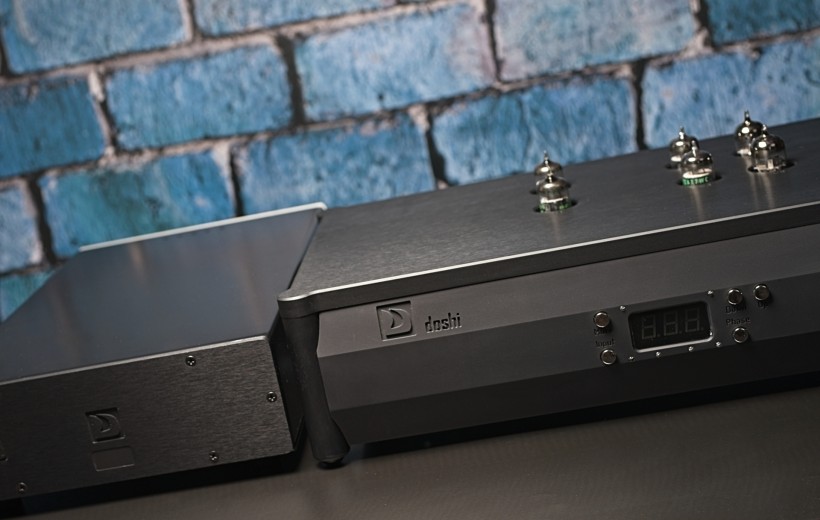
It seems that the musical or artistic quality of any recording takes precedence over its technical qualities. At least as long, as I will learn later, as the recordings one feeds it with are of at least decent quality and have a high musical value. Combined with this intensity and energy that wowed me from the start, and the incredible dynamics, I will get to soon, it makes Doshi phonostage worth considering for fans of rock, blues, and probably some pop music too. Particularly the latter genre is often quite poorly recorded, but unless the sound engineers screwed things up completely, the tested phono stage should do a good job turning them into a reasonably enjoyable experience.
Next comes an album that many lifetime fans for whatever reasons seem to hate or at least question the reason for its release, but that I do like, or even love, namely U2’s „Songs of Surrender”. I love it because finally (!) I have this band’s album that I can enjoy not only due to the music but also to the decent sound quality. Plus I love acoustic music, and the newly arranged versions of the well-known hits on this 4-record album are, in my opinion, really good. And again, the same thing hits me first – the intensity of the music, which draws me in closer to the musicians, lets me feel their presence, their commitment to what they do, and the passion they put into their songs. Looking beyond the energy of the performance I have to appreciate also (again) the resolution of the presentation that gives me all the details of Bono’s vocals, Edge’s intricate guitar playing, Adam’s bass lines, and Larry’s somewhat gentle drumming.
Except for the huge soundstage, as these are all studio recordings and no one tried to create an impression of a huge space surrounding musicians, there is everything any demanding audiophile expects. Both bands’ extremes are nicely extended, the bass goes down as deep as needed, and it has surprising authority and a kick. Admittedly, it is slightly soft or round in the lowest regions, but remember – it’s an acoustic bass, not an electric or electronic one, so not being super-tight is in its nature. Yet there are no issues with timing, the dynamics are better than good, and I have no complaints regarding pace & rhythm although I plan to revisit that issue later with some blues albums to make sure.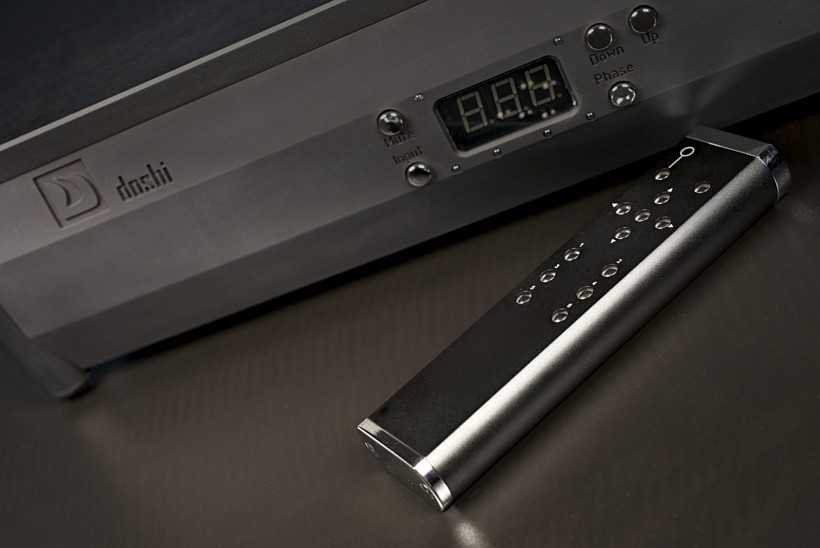
The treble seems open and vibrant, there is a lot of energy there, but no dryness, no aggressiveness, no harshness present in almost all other U2 recordings. There is some sibilance in Bono’s voice but it sounds absolutely natural, it’s a feature, not a flaw. The midrange is beautifully rich, and colorful, yet open and transparent. An abundance of tiniest details and subtleties again surprises me a bit, as I didn’t know it was there. With the Doshi phono stage the flow of music is sensational – there is this velvetiness to the sound, but when needed I can still hear a bit of that rock „dirt” or „roughness” present even in those acoustic versions. It is, again, an intense, immersive experience so I have no choice but to play all eight sides of this album putting the assessment aside for the time being and following wherever the band’s members want to take me.
The next album is hardly a candidate for the audiophile canon, yet I use it in my tests quite often. The sound is surprisingly good even though it is a digital recording. Seconds after the stylus drops into the groove of Spyro Gyra’s „Fast Forward” I start to wonder whether the tubes on top of the Evolution Phono Preamplifier are there just for show. The dynamics are incredible, PRAT excellent, the kick drum kicks hard, the electric bass is nothing short of visceral, both are tight, fast, the sustain is long, and yet the leading edge is lightning fast. In other words, I get all the traits of a high-end solid-state phonostage. The music is flowing, and rocking, and my feet start to dance without asking if I want them to… What’s happening?
It is time to play some quality releases to find out how refined and revealing the Doshi Audio Evolution Phono Preamplifier truly is. One of them is the double 45 r.p.m. Mobile Fidelity release of Patricia Barber’s „Companion”. What makes this particular edition sound so great makes it also annoying. There is no denying that while the sound and release quality are fantastic and offer a unique experience one doesn’t want to end, each side runs out, so to speak, very quickly, too quickly simply because a regular album was „stretched” over four sides of the 45 r.p.m. release. So I have to get up from my chair every few minutes and rush to the deck to flip the record over or replace it with another one. Still, the music and performance are stunning. The whole experience is more realistic, more ‘here and now’ than with any of my (to their defense, way cheaper) phonostages. In other words, some or even quite a lot of credit for the extremely good presentation has to go to the tested Evolution Phono Preamplifier.
The bass opening the album is big and heavy, and so is its sound that I can more than just hear, I can feel it too. When Patricia’s vocals enter it seems as if she is here in my room. The voice is deep, a little dark, and yet the natural sibilance is there too. The key word here is „natural” – one that is a feature, not a downside. With all that’s going on on the stage, the spotlight is on Patricia whenever she starts to sing. It is about more than just placing her in the middle and in the foreground, it is also about conveying her… magnetism, for the lack of a better word. Evolution Phono Preamplifier also keeps the background very quiet (so the noise is at a very low level) which translates to the precision of presentation down to the smallest details, into clarity and transparency of the whole presentation, into the beautiful, rich timbre of the voice and instruments.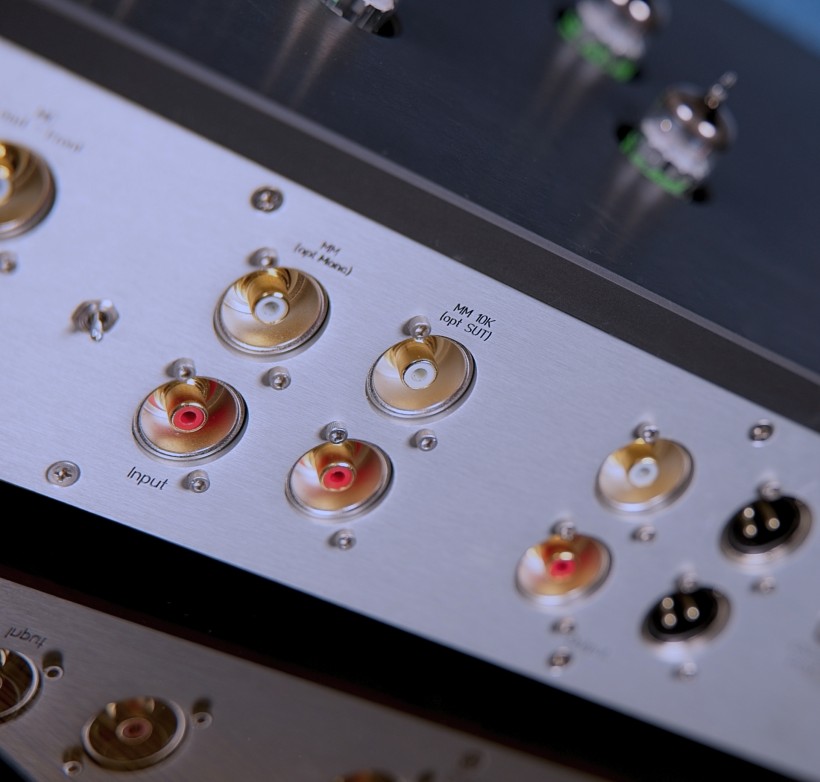
How about that Hammond? It’s deep and airy at the same time, its sound either stays quietly in the background or surfaces powerfully to the front taking the lead. Again it is clear how resolving the Doshi Audio phonostage is, and how revealing, as it allows me to study effortlessly the deeper layers of the mix down to the tiniest details and subtleties. With a recording of such a high quality it is easier to appreciate the remarkable micro-dynamics, the tiniest tonal and pitch shifts, or in other words all the details that combined produce such a convincing and engaging whole, that make the experience so intense and so real. It is further enhanced by the brilliantly reproduced ambiance of the venue, with long reverb, with clearly marked participation of the audience clapping and having as much fun as I do.
Speaking of great sounding, yet annoying due to the fact how often I have to get up to switch the side, albums next I listen to Cannonball Adderley’s „Somethin’ Else” released by Classic Records also on 45 r.p.m. one-side records. I listened to it when reviewing all the very best phonostages so I have to do it also this time. I used it also a few times when listening with a group of people as a way to silence them. Because if the system is capable it grabs everyone’s attention right from the start. And so it does also this time. I find myself at the edge of the chair to get a bit closer to the musicians who are present in my room, almost within a grasp. The magical Miles Davis trumpet is so clear and crisp and vibrant that it almost (!) pierces my ears. That’s what makes it so special, so real, so natural.
Hank Jones’ piano seems a touch muffled, yet deep and colorful. Sam Jones’ bass only ‘whispers’ in the background and yet its sound is deep, textured, and properly weighted. And so are Art Blakey’s drums – tight, quiet, sort of hidden in the background, yet necessary to keep things going. The cymbals may not be as powerful, and so vibrant as in some other recordings, but Doshi Audio phono stage plays them in a pure, energetic way. Last but not least, Adderley’s sax. It’s smooth and dark and deep, yet so vivid, so here and now. The conversation between Adderley’s and Davis’ instruments is delivered in a brilliant, powerful, totally immersive way. I can’t help listening to the whole album more than once with a volume pushed up beyond the regular level, also because no matter how hard I push, the setup delivers the music in a clean, orderly way.
On that note, I reach for a somewhat controversial album that I like. It is a real challenge for analog rigs as not that many cartridge/tonearm sets are able to play it without skipping the groove or distorting the sound. It’s Tchaikovsky’s „1812 Overture” on Telarc, the one with real bells and cannons. Evolution Phono Preamplifier plays it seemingly effortlessly. The thunderous cannons sound powerful and visceral so I can feel them in my bones. The tested phonostage easily follows my analog rig suit in delivering the fastest, most energetic impulses in a very clean, precise way. The bells are vibrant and the sustain phase is really (properly) long. The orchestra is as well-organized, nicely layered, powerful, and dynamic as with any other top phonostage I know regardless of featured technology (solid-state or tube). I push the volume up again, as the music truly calls for it and it doesn’t change a thing in terms of precision and clarity of the sound. It only gets even more impressive. Long story short, Doshi Audio Evolution Phono Preamplifier’s ability to convey complex, highly energetic performances with explosive dynamics is beyond what most competitors offer.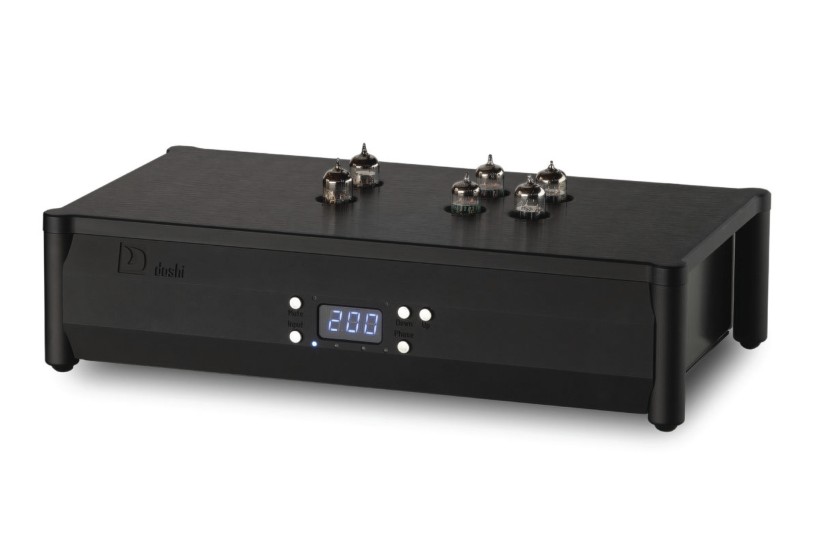
The very last album I listen to before wrapping the review and packing Doshi back into its box is the 45 r.p.m. IMPEX release of one of my favorite albums of all time, „Friday Night in San Francisco”. Based on everything I’ve heard so far with Evolution Phono Preamplifier I know what to expect. And yet, it still manages to surprise me. All the expected features of the presentation – intensity, energy, and dynamics seem to reach an even higher level. Yet, there is still also this very natural flow of music, there is clarity, and there is remarkable resolution that allows me to study the technique of any of the three guitar geniuses of my choosing. The sound is open and spacious, and the impression of participation in a live event is irresistible due to how present the performers are, how nicely the ambiance of the venue is conveyed, and how real and enthusiastic the crowd is. Listening to this album is always a unique experience for me but Doshi Audio’s phono stage brings it to another level, one that only a handful of the best of the best that visited my room in the past, could compete with.
Summary
I sort of knew what level of performance to expect as I listened to Doshi Audio’s phono stage numerous times before at various shows and in J.Sikora’s listening room at their headquarters. Yet, listening to it in my system, not necessarily the best one among them, but a very good one and one I am most familiar with, gave me an ultimate confirmation. I have no doubts that the Evolution Phono Preamplifier belongs among the very best money can buy. It offers absolutely top performance, it has it all – you name it, plus a remote control that makes using adjustments easy and convenient. What’s most important though, is that Doshi Audio Evolution Phono Preamplifier turns listening to music into a touching, incredibly enjoyable experience, that is as musical, as immersive, and as natural as only the very few, best of the best phono stages I know are. Or as Nick said, it is as good as it gets, and the rest is a matter of taste – I concur. A fantastic device that fully deserves our Award.
Prices (when reviewed US Listing!):
- Doshi Audio Evolution Phono Preamplifier 1MC/2MM inputs: 19.995 USD
- Doshi Audio Evolution Phono Preamplifier 2MC/1MM inputs: 22.995 USD
Manufacturer: DOSHI AUDIO
Polish Representative: JSIKORA
Technical specifications (according to the manufacturer):
- Stereo Inputs: 3 total (1-MC Differential, 1-MM10K SE, 1-MM47K SE). MC input can be specified with RCA or XLR connectors Stereo
- Outputs: 2 Total can be specified with RCA, XLR (quasi-balanced) XLR (Transformer balanced)
- Gain: MC – 20db (jumper adjustable to 14db), MM – 50db. Total gain 72db
- Signal to noise: at least 80db below 1V unweighted (MC input)
- Tubes: Qty 6 (12AX7, 12AT7, 12DW7)/ channel
- Power Consumption: 29W
- Weight: 15,50 kg (Preamplifier + PSU)
- Finish: Natural Anodized Aluminum or Black Anodized Aluminum
Associated equipment:
- Digital source: a custom passive server with WIN10, Roon, Fidelizer Pro 7.10, JCAT NET XE, and JCAT USB XE cards with FERRUM HYPSOS Signature power supply, KECES P8 (mono) linear power supply for the server, JCAT USB Isolator
- D/A Converter: LampizatOr Pacific 2 +Ideon Audio 3R Master Time (USB signal regenerator)
- Analog front end: J.Sikora Standard MAX turntable, J.Sikora KV12 tonearm, J.Sikora KV12 MAX tonearm, AirTight PC-3, phono stages: Grandinote Celio MK IV, ESE Lab Nibiru V 5.
- Power amplifiers: GrandiNote Shinai, Circle Labs M200, Art Audio Symphony II (modified)
- Preamplifier: Circle Labs P300
- Loudspeakers: GrandiNote MACH4, Ubiq Audio Model ONE Duelund Edition.
- Interconnects: Bastanis Imperial x2, Soyaton Benchmark, Hijiri Million, Hijiri HCI-20, TelluriumQ Ultra Black, KBL Sound Zodiac XLR, David Laboga Expression Emerald USB, David Laboga Digital Sound Wave Sapphire Ethernet
- Speaker cables: Soyaton Benchmark
- Power cables: LessLoss DFPC Signature, Gigawatt LC-3
- Power: Gigawatt PF-2 MK2 and Gigawatt PC-3 SE Evo+; a custom power line with Gigawatt LC-Y in-wall cable; Gigawatt G-044 Schuko and Furutech FT-SWS-D (R)
- Network: Silent Angel Bonn N8 + Silent Angel Forester F1 + optical LAN isolator
- Racks: Base VI, Rogoz Audio 3RP3/BBS
- Anti-vibration accessories: ROGOZ-AUDIO SMO40 and CPPB16 platforms and ROGOZ AUDIO BW40MKII feet, Franc Accessories Ceramic Disc Slim Feet and Wood Block Platform, Graphite Audio CIS-35 and IC-35


